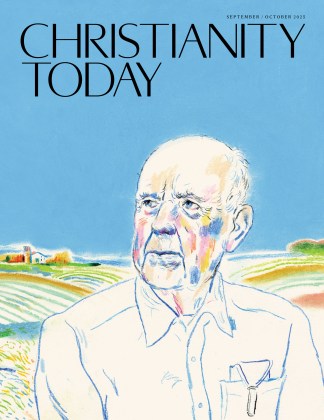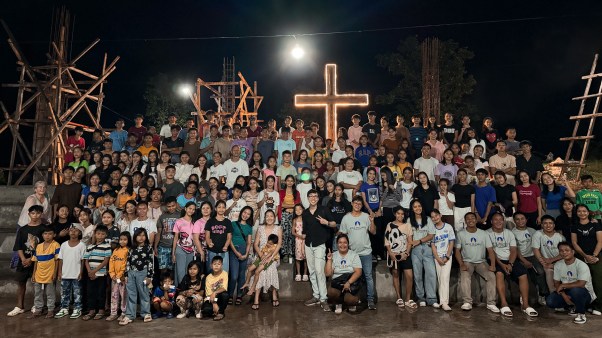(Editor’s note: Ken Morefield is at the Toronto International Film Festival. This post originally appeared at his 1More Film Blog.)
I became acquainted with grief at a very young age. As a result, for significant periods of my childhood and even into young adulthood, I felt I knew something my peers didn’t. Now in middle age, I understand intellectually that more of my peers have had what is a very common life experience, but because of the experience of formative years, I’m still always surprised when the representation of grief in art–particularly art from those who are not yet in their twilight years–rings true.

Huma Abedin's personal essay for the September issue of Harper's Bazaar plays out an all-too-familiar scene in the theater of sex and politics. In this cast, there are only two characters: the Good Wife and the Better Man. In the article, Abedin christens her husband, New York City mayoral candidate Anthony Weiner "a better man" who pushed through his past mistakes (which, by now, we all know of). And in a telling editorial decision, the magazine titles the article and by proxy Abedin herself as "The Good Wife," one who has remained faithful by his side through it all.
It's a clean, PR-friendly image. This article was written and published online before the nation was introduced to Carlos Danger.
And now that Weiner's public vows to abandon his sexting exploits with other women have resurfaced as, shall we say, less than sincere, it's difficult to tell which of the couple is more infamous. The typecasts are quickly deteriorating, as America can't seem to make up its mind whether it's more outraged by Carlos Danger for straying, or The Good Wife for staying.
Countless motives have been ascribed to Abedin for "standing by her man"—that she's staying as a boost to her own political career, that her Muslim faith or Saudi Arabian upbringing compels her to leave divorce out of the options, that she's following in the footsteps of Hillary Clinton's example. We'll never know.
What can be said of Abedin, however, is that she did something many other politico's wives in similar situations did not. At a press conference with her husband, Abedin exercised a quality I admire in any woman: raising her own voice. She articulated to the press that hers is a personal decision she made "for me, for our son, and for our family."
But what happened next is where her position becomes problematic. Because in the next breath, Abedin extended her own choice to forgive and stand by her unfaithful husband as a prescriptive for all—for voters, for national viewers, and perhaps most dangerously, for all women who have ever found themselves in a cycle of broken trust.
This line of thought is consistent with her Bazaar essay, in which she invites readers to join her in the ranks of The Good Wife, even infusing her choice with moral force:
New Yorkers will have to decide for themselves whether or not to give him a second chance. I had to make that same decision for myself, for my son, for our family. And I know in my heart that I made the right one.
Abedin may maintain her decision is a personal one, but the subtle invitation to follow her lead sends the message to women everywhere: The Good Wife is one who is ever faithful to her man, whether or not he is faithful to her.
Yet, in reality, relationships are far too multi-dimensional for such a clean caricature. In fact, The Good Wife does not—and should not—look the same from one marriage to another. For some women, it might look like bringing public accountability to her husband's destructive habits. It might look like checking herself and her children into a hotel for a night or two because their home has become physically unsafe. Certainly sometimes, the best thing a wife can do is to stand by her man. Yet other times, The Good Wife earns her name by standing up to him instead.
The point is, to construct a one-size-fits-all template of The Good Wife is socially irresponsible. It's a tired cast of characters, and not only in the scandal-studded political ring. It's a typecast that's long overstayed its welcome in the Christian narrative as well.
In some ways, it's easy to see why. The Christian convictions of male headship, female submission (in some circles), and the sanctity of marriage can lead some women to believe God calls them to stay in repeatedly unfaithful or abusive relationships. In fact, as William Bradford Wilcox reports in Soft Patriarchs, New Men, individuals with strong religious beliefs statistically stay in abusive relationships longer than others without religious moorings. In his study, he found that Protestant wives, at 2.8 percent, are the least likely among demographics to report domestic abuse in their home. Of course, this doesn't mean abuse isn't happening.
I recently listened in on a group of women as they described the ways they see the church perpetuating this image of The Good Wife as one called to remain in even a toxic marriage. As one woman put it, "The hammering of 'wives, submit to your husbands' was much louder than the idea of 'as long as what he wants doesn't go against God's will.'" Another watched her mother, married to a physically abusive alcoholic, receive the spiritual advice: "Pray for him, stand by him, and do not slander him." Another answered, "My own husband uses the Scripture of 'God hates divorce' to invoke guilt when he knows or thinks I've had enough. Basically, to him, the idea of marriage is more important than the people in the marriage."
And yet, if we know anything about Jesus, it's that His divine mission and identity is rooted in proclaiming "freedom for the captives" (Isa. 61:1, Luke 4:14-21) advocating for the oppressed (Ps. 9:9) and defending the weak (Luke 10:30-37).
Likewise, if we know anything about God's design for men and women, it's that he is a creator of personhood—of male and female in the uniqueness of his image (Gen. 1:27) rather than rote templates. As a result, a singular definition of The Good Wife is not only inaccurate but to ask women to conform to it does a disservice to divine Image-bearing personhood.
In the end, the reality is we don't know the outer limits of Weiner's addiction, Abedin's forgiveness, or their commitment to each other. Weeks before the mayoral primary, the charade of The Good Wife and The Better Man continues—though given Weiner's latest poll numbers, it seems many voters don't want to play along.
But as Carlos Danger fades from the headlines, I hope The Good Wife image will likewise be retired—letting us get back to the dynamic complexity of humans as Image-bearing individuals, not as cheap typecasts.
Stephanie S. Smith is a freelance writer and current editor for Barna Group, previously at RELEVANT Media Group. She lives in Orlando with her husband, and you can find her at www.stephaniessmith.com or tweeting @stephindialogue.
There’s not a whole lot about Emilio Estevez’s The Way that doesn’t ring true. Given the fact that the film tackles some of life’s deepest emotions and largest themes–grief, love, faith, community–that’s quite a compliment.
Martin Sheen plays Tom Avery, an American ophthalmologist who receives word that his son has been killed while walking the Camino de Santiago, a pilgrimage trail in the Pyrenees mountains between France and Spain sometimes referred to as The Way of Saint James. Perhaps impulsively or perhaps in desperation, Tom decides to walk the pilgrims’ trail himself, to finish the journey his son began.
Obviously, such a role calls for an actor of immense talent, both to convey the depth and layers of feeling of a parent mourning his child and to eschew the more melodramatic histrionics that would cause such material to become overly and overtly sentimental. Sheen, one of our national acting treasures, is perfect for such a part, bringing it gravity but also dignity. I love that in introducing a movie about fathers and sons, rituals and traditions, Estevez chose to describe Sheen by borrowing from another famous director, John Huston, talking about his own father. “He never tried to sell you something.” The film needs that kind of iconic confidence at its center, because for long periods Tom, in his grief, goes inside himself, and the film must have the confidence to let him, to allow us to be one of the community with him, each broken in his or her own way, each striving for understanding, light, and hope.
Do you want to know one thing that is true about grief? Movies tend to think that what we remember and treasure in our hearts are the big gestures people make to acknowledge the hugeness of our loss. But that’s not the case. What stays with you are scores of small kindnesses from people that remind you that life is worth living, that in our sadness, our emptiness, and our poverty, most people can be very, very decent. “To be kind,” George MacDonald once wrote, “neither hurts nor compromises.” It may be the only thing that doesn’t.
Estevez talked rather self-effacingly at the Toronto International Film Festival of not directing his father, of surrounding himself with talented people and “getting out of the way.” He did direct, Sheen insisted. It’s easy enough to see how both descriptions are true. In a post-Cahiers film world, we take certain theories of auteurship for granted. Our picture of the director is of someone who, Hitchcock-like, plans and controls every detail of the film in his head. Estevez spoke of making a film about community by making a community, using natural light, shooting in Super 16 and making technical choices appropriate to the thematic content of the film. These are directorial decisions that shape the film and were appropriate, but the creation of a community of like-minded people pursuing a goal should not be underestimated. The care and compassion these people have for each other reaches beyond performance and says something about the material’s and location’s ability to affect actors and not just vice-versa. I wish he hadn’t used the device of having the father occasionally “see” his dead son, but–as one viewer stressed to me–that (hearing/seeing those who are absent) is an experience, hinted at by other characters in the film which is not uncommon to those who are grieving.
In circles in which I sometimes converse, there have been, for as long as I can remember, discussions about Christians in the art, about how to get more films that are faith friendly and about the corrosive moral effects of “Hollywood” or the “Hollywood culture.” Every now and then, though, I’ll run across a song like Leonard Cohen’s “If It Be Your Will” or a film like The Way, that not only puts “Christian” films to shame but that makes me exasperated at the whole notion of “Christian” as an identity politics genre. If you want more great Christian art, go find great artists and support them in their desire to speak, write, and represent the truth. Hollywood is made up of people–many of whom, it turns out, are more complex, interesting, and thoughtful than we might guess based on nothing more than a quick glimpse of their IMDB filmography.
One audience member at the Toronto Film Festival who had done this pilgrimage himself spoke glowingly of how the film’s latter scenes captured perfectly the experience of arriving in Santiago de Compostela. The Way is the first non-documentary film granted permission to film inside the church, and the scenes of the pilgrims arriving, how each responds to the rituals, to each other, and to the dawning realizations that they are neither the first nor the last to walk the path they’ve walked or bear the burdens they’ve borne, is as deeply moving and passionately spiritual a moment as you are likely to get in commercial, narrative film. You know what would be a little miracle that would make me happy? If Christians who wanted to “send Hollywood a message” with their pocketbooks would eschew boycotting the next “R” rated slezefest that gets them all tied up in knots and try the reverse for once. Pick up the phone and call your favorite studio and say, “I’ve got $10 and I really want to see this movie.”
Hey, it’s worth a try. Turns out The Way–here’s the kicker–doesn’t yet have a major distribution deal.
The Way is funny, sad, somber, and, above all, true. It is life-affirming in most of the best senses of the phrase. It’s easily one of my favorite films of the year thus far. If you get an opportunity to see it, seize it. You won’t be sorry. It you don’t, that’s okay, too, just so long as you promise not to complain that there’s nothing but sex and explosions at the multiplex these days.
(Photo by David Alexanian, Copyright 2010).








